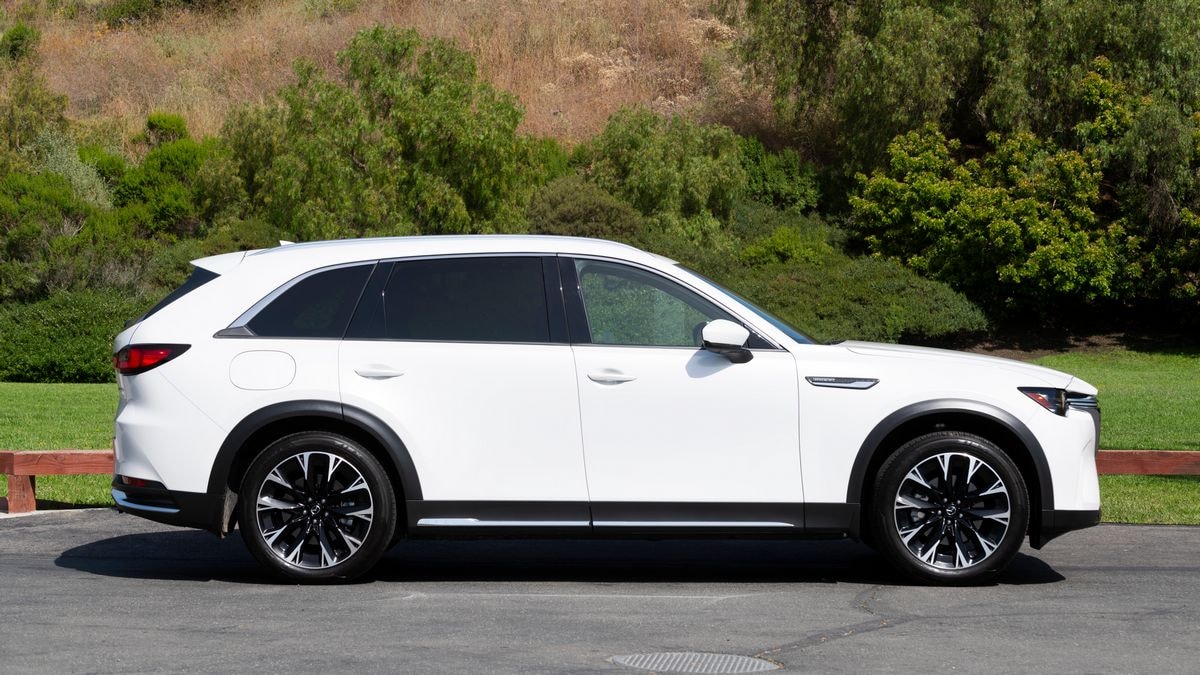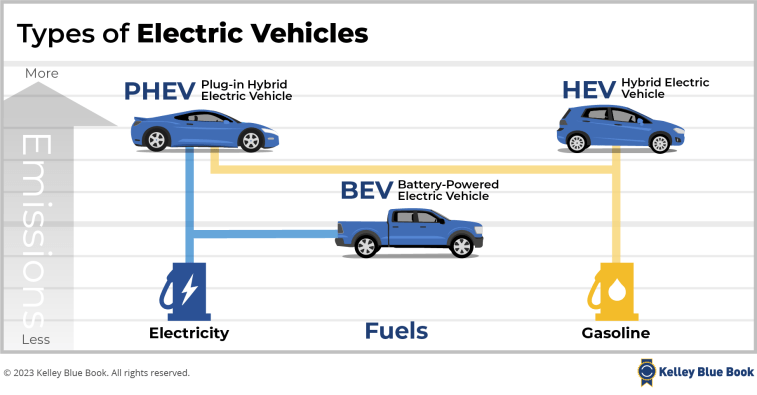Quick Facts About Choosing a PHEV
- PHEVs combine electric power for daily commutes with a gasoline engine for extended range, offering the best of both worlds.
- Lower operating costs and tailpipe emissions can make PHEVs a smart choice despite higher upfront costs.
- From luxury brands to mainstream automakers, PHEVs come in various styles, including SUVs, sedans, and even a minivan.
Drivers considering shifting to an electrified car face a crucial decision that depends on driving habits, charging availability budget, and more. Cox Automotive, Kelley Blue Book’s parent company, predicts that electrified vehicles will move into the mainstream in 2025, with 1 in 4 new automobiles sold powered by electricity in some way. Should you go all-in with all-electric or take the hybrid route with a plug-in?
Fully electric cars do not appeal to everyone. Yes, there’s the lure of tailpipe-free emissions. And the most advanced electric cars on the market today can drive distances of about 400 miles between charges. They still require charging, but that’s no problem if you recharge overnight at home. However, using public stations during extended road trips takes longer than filling up at a gas pump.
A plug-in hybrid electric vehicle, or PHEV, balances eco-friendly motoring and go-anywhere flexibility for drivers. It also helps you extend your mileage between trips to the gas station. Most commuters can drive to and from work on electric power alone, while the gas engine stands in reserve waiting for longer road trips.
Read on, and we’ll explain how plug-in hybrids and electric cars differ, as well as their advantages and what you can expect from a PHEV.
- How Plug-in Hybrids and Electric Cars Differ
- Pros and Cons of PHEVs
- Brands With Plug-in Hybrid Models
- Bottom Line on Choosing a PHEV
RELATED: 10 Best Used Plug-In Hybrid Vehicles Under $20,000
How Plug-in Hybrids and Electric Cars Differ
Think of a PHEV as a vehicle that splits the difference between a conventional gasoline car and a fully electric vehicle.
An EV doesn’t have a gas engine and uses only electricity for power. A typical PHEV can handle a drive of 20 to 40 miles using electric power alone. When the propulsion battery pack is depleted, its gasoline-powered engine fires up to keep the PHEV moving down the road.
According to the United States Department of Transportation, most Americans travel about 14,500 miles annually, or less than 40 miles daily. So, owning a PHEV can work a bit like owning an EV for day-to-day driving. You might be able to take the kids to school, drive to work, and run errands in a PHEV without using any gas. Even if your daily round-trip commute is more than 40 miles, fear not. Some workplaces have chargers on-site, and a PHEV battery can typically charge up within a few hours. Similarly, some PHEV drivers replenish the energy consumed to reach a shopping center by plugging into a charging station while they shop.
Why isn’t there a plug-in hybrid with a 100-mile range? There likely will be one someday. Battery technology is moving at a rapid rate. Power-dense batteries that take up less space are under development. A few years ago, drivers considered that a good PHEV drove 20 miles. Today, it’s more than double that distance.
PHEV Appearance
PHEVs essentially start as gas-fueled cars. Pop the hood, and you’ll find a gasoline engine with an electric motor typically nestled next to it. Hidden under the back seat or somewhere in the trunk/cargo area is a battery pack larger than the shoebox-size one under the hood but not nearly as big as what powers a fully electric car.
Only the most discerning eyes will notice a difference between a PHEV and an equivalent gas or hybrid vehicle. A PHEV is perfect for eco-friendly drivers who still want the get-up-and-go of gas for long trips.
You’ll find two small doors outside the vehicle—one for fuel and one for electric charging. Most of today’s PHEVs look just like their conventional gas-fueled counterparts, aside from that extra charging door.
By contrast, an electric car discards the gasoline engine entirely. EV drivers plan trips away from home more carefully around the vehicle’s charging needs. Most EV owners recharge overnight at home.
Still, both EVs and PHEVs need time to charge on the Levels 1 or 2 chargers that most owners will put in their garages or use when out and about.
Pros and Cons of Plug-in Hybrids
Shoppers weigh the advantages and disadvantages of any type of vehicle. Here are some benefits and drawbacks for PHEVs.
| PHEV Pros | PHEV Cons |
| Operating cost: Electricity is cheaper than gas. Most drivers can use the battery for their daily needs. | Purchase cost: PHEVs can cost thousands more than their comparable gas-powered models. |
| Fewer tailpipe emissions: Many shoppers choose electrified vehicles to reduce their daily carbon emissions, and every little bit helps. | Complex system: Electric motors and batteries rarely fail, but a PHEV has two drivetrains that can cost more to fix than a solo gas engine. |
| Distance: The total range for a typical PHEV is 400 miles, compared to about 300 for an all-electric model. | Faster depreciation: PHEVs may depreciate faster than comparable gas models. That’s great for used shoppers, not great for owners selling or trading. |
| Charging opportunities: PHEVs can be charged with standard outlets, and 60,000 public Level 2 charging stations are available nationwide. | Charger installation: PHEVs can charge slowly using a standard wall outlet, but many owners install a Level 2 charger for faster recharging at home. |
| Tax credit: Eligible buyers can potentially receive a point-of-sale tax break to help defray the cost of a new PHEV. | Few tax credits: As of this writing, only one PHEV (the Chrysler Pacifica Hybrid minivan) is eligible for the $7,500 federal tax incentive. |
MORE: Hybrids vs. Plug-in Hybrids: What Are the Differences?
Brands With Plug-in Hybrid Models
Current PHEV models cover a range of categories and price points.
Luxury car automakers, including Alfa Romeo, Audi, Bentley, BMW, Land Rover, Lexus, Lincoln, Mercedes-Benz, and Volvo, offer PHEV versions of several models. Volvo’s T8 powertrain—found in several models, including sedans and SUVs—is perhaps the most common among premium brands.
Mainstream automakers offer a variety of options. Dodge, Ford, Hyundai, Jeep, Kia, Mazda, Mitsubishi, Toyota, and Volkswagen have PHEVs in car and SUV styles.
The Chrysler Pacifica Hybrid is the only minivan PHEV option on the market.
Adventurous types can look to the Jeep Wrangler 4xe, which boasts tremendous off-road capability.
MORE: 10 Longest-Range Hybrids of 2024-2025
Bottom Line on Choosing a PHEV
Plug-in hybrid electric vehicles blend the eco-friendliness of electric power with the range flexibility of a gas engine, making them ideal for daily commutes and longer trips. They offer benefits like lower operating costs, reduced emissions, and potential tax credits but come with higher purchase prices and faster depreciation. With options from luxury to mainstream brands, PHEVs provide a practical choice for many drivers.
Editor’s Note: This article has been updated since its initial publication. Andrew Ganz contributed to the report.










